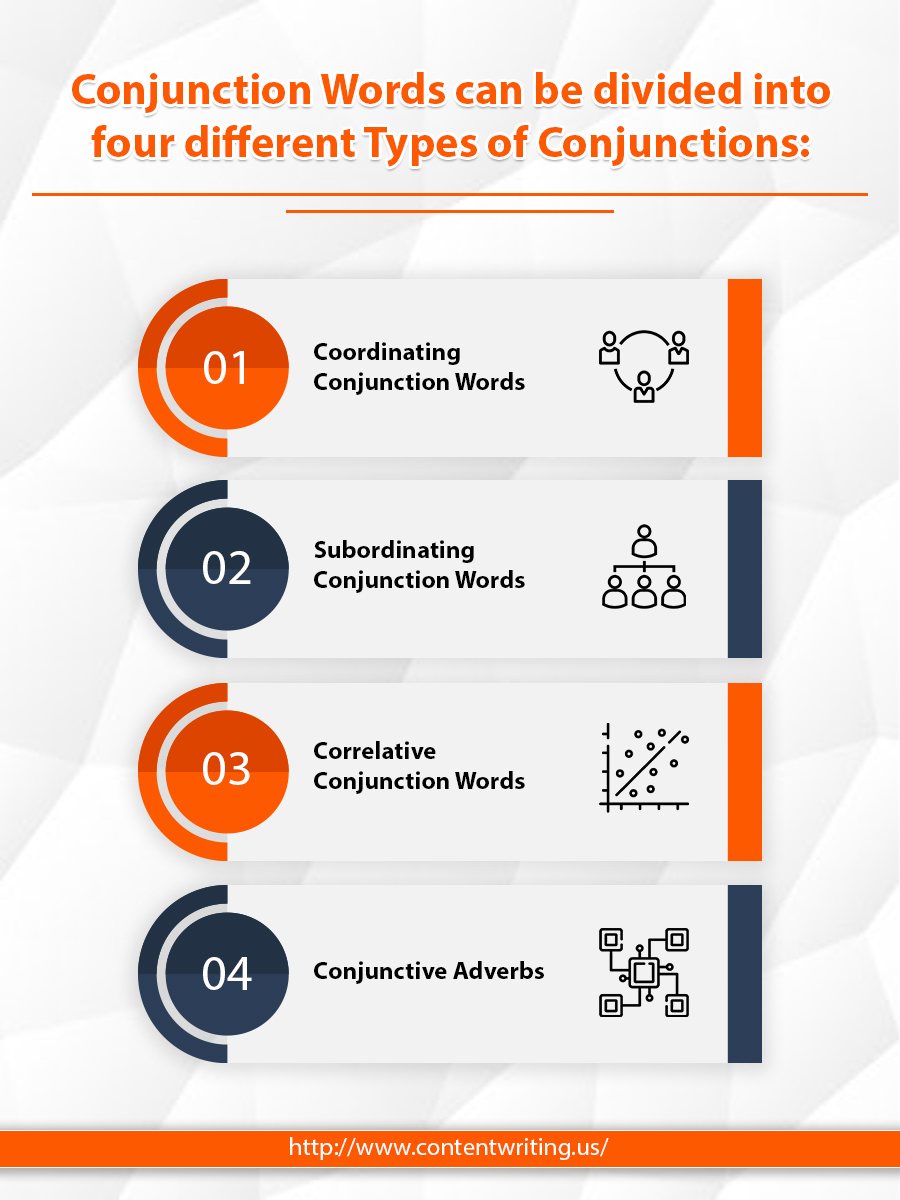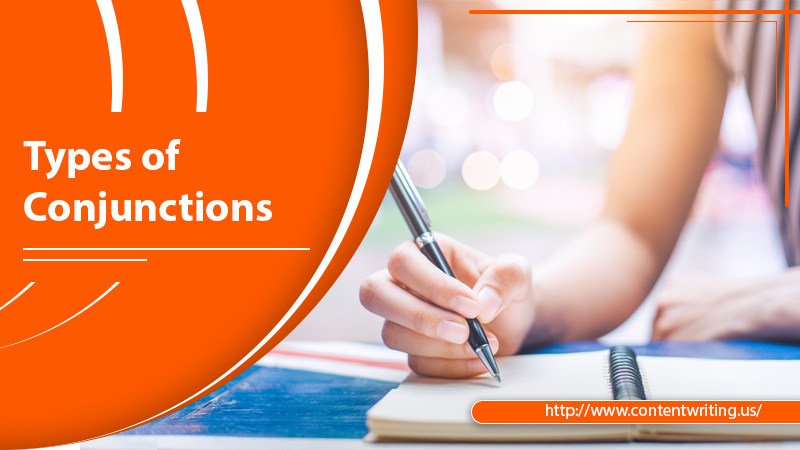In present-day English, there are many types of conjunctions to use. Conjunction is part of speech that creates a sentence and allows you to connect words, clauses, and terms collectively. Types of conjunctions had been an essential part of English grammar.
Knowing a list of conjunctions or the conjunction examples list will assist you not only be clear with your sentences but additionally sound more knowledgeable. The conjunction words list contains important guidelines in English grammar. The kids had been asleep. Their dad and mom had been asleep. Their puppies had been asleep.
These sentences work satisfactorily separately however appear a bit repetitive, don’t you think? Instead, let’s use a conjunction to connect them collectively. The kids, their dad and mom, and their puppies had been asleep. That seems a lot better, right?
Want to understand what is a conjunction? Conjunctions are very useful words that join parts of speech collectively to shape more complicated sentences. Let’s study more about those grammatical matchmakers and how we can use them to write better sentences we’ll love. In this article, we will talk about a few popular types of conjunctions and word examples in detail.
What is a Conjunction?
A Conjunction is a phrase that joins extra phrases, terms, or clauses in a single sentence. Types of conjunctions help us to share those thoughts and make connections more easily. Without them, we’d need to make lots of short, blunt little statements. The most common examples are ‘and’,’ or’, ‘however’, and ‘because’.
In English grammar, a conjunction is one of the elements of a sentence you could use to mix a couple of words, clauses, or phrases collectively. Different types of conjunctions include “and,” “or,” “while,” “though,” “expect,” “until,” “although,” “whether,” “so,” and “however,” but there are numerous others in American English.
Prepositions can once in a while function as conjunctions, relying on their placement in the sentence. By the use of conjunctions in your sentences, you could make complicated sentences instead of easy sentences.
The Uses Of Conjunctions
Now that you understand what is a conjunction. Let us recognize the use of types of conjunctions in the words list with the help of a few realistic and easy examples –
- She will go to her grandparents and she will visit her friend’s residence afterward.
- You can either be comfortable or stressful, however you cannot be both at the same time.
In the above sentences as we will see that the use of and in the first sentence creates a better flow and makes it easy to examine let’s see how it might sound if we don’t use it, “she will go to her grandparents. She will visit her friend’s residence afterward.”
Without the use of and here the sentence sounds blunt and if we use and in the above sentence a better connection and flow gets facilitated indeed. In the second sentence, the use of both, or, and but indicates actually only one element is possible and thus, it makes it easy for the reader to recognize the sentence better.
Categorization – Types of Conjunctions

Conjunction words can be divided into four different types of conjunctions:
- Coordinating Conjunction Words
- Subordinating Conjunction Words
- Correlative Conjunction Words
- Conjunctive Adverbs
There are mainly four types of conjunctions as elaborated below –
1. Coordinating Conjunctions
- Coordinating Conjunctions link equal parts of a sentence which include terms and causes.
- When a coordinating conjunction is for to enroll in independent clauses, we will use a comma.
- The most typically used coordinating conjunctions are for, and, nor, however, or, yet, etc. The acronym for coordinating conjunctions in FANBOYS: For, And, Nor, But, Or, Yet, So.
2. Subordinating Conjunctions
- They help in Linking an independent one to a dependent clause.
- when, where, while, which, who after, before, though, etc. These are the most commonly used Subordinating Conjunctions used.
3. Correlative Conjunctions
- These paired Conjunctions generally get used at two places in a sentence to connect two equal grammatical entities.
- neither.. nor, either…or, not only….but, whether..or etc. These are the most commonly used correlative conjunctions.
4. Compound Conjunctions
- Compound Conjunctions are the phrases that are used as conjunctions
- as well as, as soon as, so that, provided that, such that, in order that, etc. These are commonly used compound conjunctions.
What are Some Common Conjunctions?
Below are lists of common types of conjunctions you can use in your writing, and there are plenty to pick from. Except for the coordinating conjunctions, these lists aren’t exhaustive.
Coordinating conjunctions list
To remember the seven coordinating conjunctions some people use the mnemonic “fanboys”.
- but
- or
- yet
- so
- for
- and
- nor
For example:
- He was late for the class so he took a shortcut path.
- Her favorite colors were purple and red.
- She doesn’t like milk, nor does she like orange juice.
Correlative conjunctions list
- but also/not only
- because/as
- both/and
- or/either
- nor/neither
- or/whether
For example:
- He not only plays the violin but also the flute.
- You can have either strawberry or butterscotch ice cream.
- Such was his strength that he moved the fallen tree effortlessly.
Subordinating conjunctions list
- before
- by the time
- in case
- now that
- since
- after
- although
- as soon as
- because
- unless
- when
- whether or not
- while
For example:
- We had to postpone the class session because it was snowing.
- He doesn’t go do horse riding classes anymore, since he had the injury.
- The house was messed up after the party that we had last night.
Conjunctive adverbs list
- finally
- however
- nevertheless
- then
- after all
- besides
- consequently
- therefore
For example:
- The heavy snow hid the roads; therefore, many people were trapped.
- Daniel is a fabulous drummer; however, he hardly ever practices.
- I never liked having vegetables for dinner. Nevertheless, I ask my kids to have them.
Utilizing Different Types Of Conjunctions Together
It is just great to apply all the different types of conjunctions together in the same sentence. Just do not forget that coordinating conjunctions are to join independent clauses and subordinating conjunctions is to join subordinate clauses to independent clauses.
Sometimes, sentences can get very lengthy and complex, however, you continue to need to keep in mind when and wherein to apply commas.
Here is an example of a complex sentence that makes use of all four types of conjunctions. Take notice that only the coordinating conjunction that connects independent clauses makes use of a comma:
- I tried to persuade my parents I was innocent, but my plan failed because both my younger brother and my younger sister instructed them that I broke the window.
Rules Of Different Types Of Conjunctions Words Examples
Here are the crucial guidelines of conjunctions and a few conjunction words examples that you should understand:
- We use and, as well as, both..and, not only..but also to actually emphasize the connection among things.
- We use so…as and as…..as to reveal a comparison among things, people, etc
- Although, though observed by yet or comma(,) Pairs like no sooner…than, hardly..when, scarcely.. when must be utilized in the right form.
- Lest get either followed by should or the first form of the verb.
- Since, lest is a bad word it must not be used with not, never
- Until is time-orientated and except is action-orientated and they’re bad phrases and hence, have to not be used with no, not, never, etc.
- In affirmative sentences, the terms doubt and doubtful are followed by if or whether while in negative sentences, the terms doubt and dubious are accompanied through that.
- The connectors not only…but also must be placed before the elements are joined.
- Between is accompanied by and from is accompanied through to
- Neither of means none of them; none of is used for more than; either of means one of them; when more than are concerned, one in all is used.
- After rather/other, the subordinating conjunctions have to be used.
The Job of a Conjunction
Remember, the principal job of a conjunction is to connect collectively distinct elements of a sentence that will help you join or emphasize thoughts or actions. Conjunctions assist you to form more complicated and exciting sentences and make your writing flow more smoothly.
Conjunctions: Key Learning
- These assist to connect thoughts to create an easy-flowing sentence this is really understandable.
- Remember, while conjunctions are overused, you have run-on sentences.
- Practice frequently for its proper utilization.
3 Tips for Using Conjunctions Properly
Using conjunction well depends on the type of conjunctions you’re using and where it’s far in the sentence. Here are some hints for using conjunctions well.
- Punctuate subordinating conjunction in keeping with its placement in the sentence. If the subordinating conjunction is at the start of a sentence, then use a comma following the established clause. Do not use a comma, if the subordinating conjunction comes after an independent clause.
- You typically miss a comma with correlative conjunction. They practice relation among phrases, terms, or clauses, and do not need more punctuation.
- You would possibly or won’t want to apply a comma with a coordinating conjunction. If you’re punctuating a sentence with coordinating conjunction that pairs phrases or terms, do not use a comma. If you’re punctuating or more independent clauses, use a comma before the conjunction.
Conclusion
Conjunctions play a crucial function in English grammar. They keep sentence fragments from floating around on their own, permit writers to connect series of words, and permit-related ideas to take the same place in the sentence. Yet they do have a few regulations to follow to use them well. Proper placement of punctuation is essential to keep away from grammar mistakes. Knowing the forms of conjunctions with the help of content writing services will assist you to apprehend a way to use them in distinctive parts of the sentence, so your writing is grammatically correct.
Related Post: best grammar checker tools
